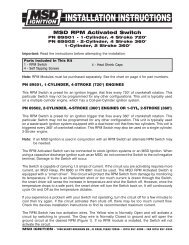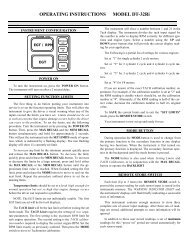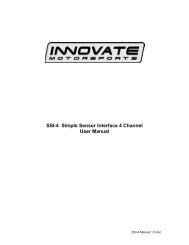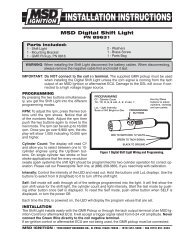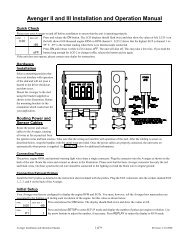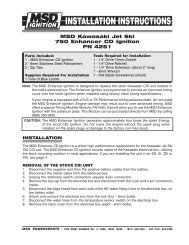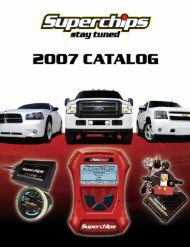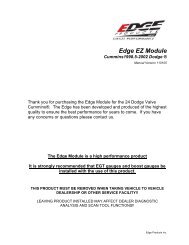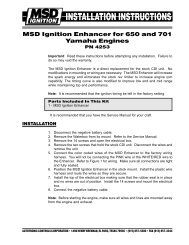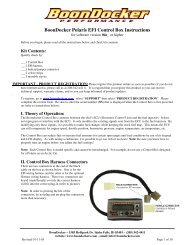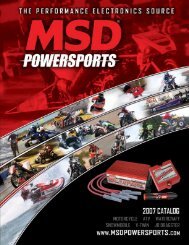BoonDocker Arctic Cat EFI Control Box Instructions
BoonDocker Arctic Cat EFI Control Box Instructions
BoonDocker Arctic Cat EFI Control Box Instructions
You also want an ePaper? Increase the reach of your titles
YUMPU automatically turns print PDFs into web optimized ePapers that Google loves.
VII. <strong>EFI</strong> Tuning<br />
Each Fuel adjustment setting goes from –20 to 99. Positive numbers add fuel and negative numbers subtract fuel. The<br />
minimum is set to –20 so accidental adjustments beyond this value don’t occur. However, this will not prevent a lean<br />
burndown! You must still take the proper tuning steps.<br />
The maximum is set to 99. This does not mean you have an effective range all the way to 99 – you will likely max out the<br />
injector before this setting is reached. Your usable adjustment range (max value) is dependent on how long the ECU<br />
already has the injector on. This will vary depending on rpms, throttle setting, temps, and can be different from sled to sled<br />
even of the same model. There is no direct relation<br />
Exhaust Gas Temperature gauges can be an effective tuning tool, but they are not a substitute for reading spark plugs and<br />
piston wash and feeling how the engine runs. Use EGTs only as a backup to verify what you see. They can be misleading<br />
under certain conditions and safe readings can vary greatly from engine to engine depending on such things as probe<br />
placement, fuel, timing, pipe design, porting, etc.<br />
Tuning tips:<br />
Important: Find the settings where your motor runs rich before you decide to go lean!<br />
1. Tune with the engine and pipe at operating temperature. The sled’s ECU will make adjustments as the engine<br />
warms up – you might think the engine needs leaner settings then later realize you are too lean once the engine<br />
warms up.<br />
2. Use the Load/Save Map feature to quickly change and compare fuel settings when testing. This can also be useful<br />
for riding under different conditions. For example, changing elevations or temperatures may require different<br />
adjustments if the stock ECU does not compensate properly for your modifications. For drag racing, you might<br />
want to run richer settings for longer distances than you would for short distances.<br />
3. To find out where a fuel adjustment setting is effective, greatly increase only that setting. Run the engine to find<br />
out when it suddenly becomes too rich – this is where that setting is effective. Be careful – you can easily flood<br />
the motor, especially with LO load or low RPM settings. To restart the engine you may have to pull several times<br />
with the throttle held wide open.<br />
4. Set the N2O setting to OFF and use the nitrous button to add fuel interactively. When the nitrous button is<br />
pressed, the amount of fuel set in the nitrous menu will be added in addition to the fuel adjustments that are<br />
already made.<br />
Also consider the following:<br />
A/F Mixture Generally EGT’s get hotter as the motor gets lean, but too lean and the temps can actually drop! It’s like<br />
turning the oxygen up too high on a torch – as oxygen is added, the flame gets hotter to a certain point,<br />
then gradually cools off until it becomes extinguished from too much oxygen.<br />
Detonation EGT’s can read low during detonation – heat is going into the cylinder and piston instead of out the<br />
pipe. Detonation often requires an experienced tuner to detect.<br />
Timing Timing can affect the pipe temperature. Generally if the ignition is retarded, more heat will build up in<br />
the pipe. Too much advance may drop EGT temps, but increase cylinder temps.<br />
Fuel Different fuels have different densities and other characteristics which can affect your mixture and fuel<br />
requirements. Oxygenated fuel will run leaner. Octane rating is important for highly modified motors.<br />
Lean spots Sometimes a motor runs hot at certain rpms and throttle positions (usually in its mid-range) no matter<br />
what. The fuel adjustment settings can be used to richen this up, but the engine may quickly become<br />
too rich and run erratic. Under light load conditions you can sometimes get away with running hot for<br />
short periods of time. Under such conditions it is best to vary the throttle position often and not stay at<br />
one throttle setting for long durations.<br />
<strong>BoonDocker</strong> – 1585 Hollipark Dr. Idaho Falls, ID 83401 – (208) 542-4411<br />
website: www.boondockers.com - email: info@boondockers.com<br />
Revised 01-21-05 Page 8 of 10




